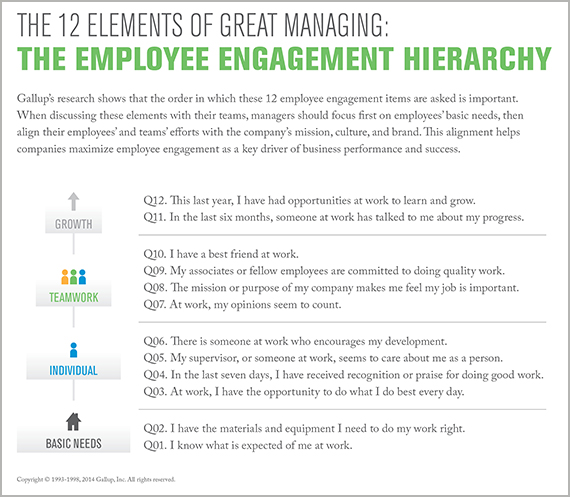Let's face it, rallying employees around a mission makes some executives uncomfortable.
At the heart of any company is its mission. A business' mission defines what it stands for -- its purpose and the reason for its existence. Mission declares the difference a company seeks to make in the world. A strong mission is lofty, ambitious, and sometimes audacious.
Many executives don't realize that mission is an underused asset in improving organizational performance and profitability, and they neglect their ultimate responsibility of aligning their brand and culture with their highest purpose. Failure to meet a company's mission-related needs is failure of leadership.
To instill a passion for the company's purpose, the best leaders in the world hold managers accountable for addressing employees' basic engagement needs. Then they focus on aligning mission, culture, and brand to empower high performance among individuals and teams. By providing this strategic direction, mission-driven leaders maximize employee engagement as a key driver of organizational performance -- and as a strong predictor of business success.

Gallup research in 2013 reinforced what our scientists have known for years: Though leaders are skilled at creating value through process improvements, they have much to learn about creating value by aligning the mission and purpose of their company with business strategies, culture, brand, and performance measures.
Let's face it, rallying employees around a mission makes some executives uncomfortable. It may seem airy to them or just impossible to measure. But perhaps they are beginning to wake up to the value of mission-driven leadership. Here are a couple of the questions leaders are asking Gallup:
- Our business is growing rapidly. We need to ensure that our mission and culture don't get lost in the chaos. How do we balance growth with staying focused on mission?
- Our industry is changing fast, and we're struggling to keep up and just survive. How do we avoid putting margin ahead of mission?
What these questions boil down to is: What is the real value of mission? And how do leaders use it to move a business forward?
The value of mission: What Gallup's research reveals
In conducting a meta-analysis of 49,928 business units across 192 organizations representing 49 different industries in 34 countries, Gallup scientists discovered that margin and mission are not at odds with one another at all. In fact, the opposite is true. As employees move beyond the basics of employee engagement and view their contribution to the organization more broadly, they are more likely to stay, take proactive steps to create a safe environment, have higher productivity, and connect with customers to the benefit of the organization.
Mission-driven leadership comes from the heart. It requires talent and guts.
How is mission such a powerful driver of organizational performance? Gallup identified five factors behind the success-promoting, margin-boosting benefits of focusing on mission:
- Mission drives loyalty across generations. Understanding a company's purpose helps employees answer yes to the question "Do I belong here?" Gallup's research shows that ensuring employees have opportunities to do what they do best every day and emphasizing mission and purpose are the two strongest factors for retaining Millennials, Generation Xers, and Baby Boomers. More than one in four Millennials strongly agree with the statement "If the job market improves in the next 12 months, I will look for a job with a different organization." This makes it more important than ever to focus on strengths and mission to drive down the cost of turnover and prevent the loss of key employees, especially among Millennials.
- Mission fosters customer engagement. A strong mission promotes brand differentiation, consumer passion, and brand engagement. Unfortunately, only about four in 10 employees (41%) know what their company stands for and what makes its brand different from its competitors'. This lack of brand awareness is not a marketing problem; it is a mission-driven leadership and management problem.
- Mission improves strategic alignment. Alignment begins with a clear purpose -- the what and why of the organization. How, who, when, and where are secondary to the enterprise's reason for existing. Mission can help leaders establish and balance priorities, set performance goals, and align rewards and compensation at all levels. If your company's mission includes a promise to provide world-class customer service, for example, then you should define and measure "world-class" service -- and hire employees who can deliver on that promise.
- Mission brings clarity. Awareness of mission guides decision making and judgment. A clear sense of what matters most helps leaders determine the best path for the company and helps them set priorities. This clarity inspires conviction and dedication.
- Mission can be measured. To maximize the value of mission and purpose, leaders need a reliable assessment of employees' attitudes about their work and how it connects with the company's purpose, such as their responses to the "mission and purpose" item in Gallup's Q12 employee engagement survey. Leaders and managers should use this information to guide them as they tackle the challenge of helping employees connect their work behaviors to the company's ultimate purpose.
Because leaders bear the responsibility of instilling passion for the company's mission, simply measuring employee engagement year after year won't improve engagement -- or business results. To reap the benefits of focusing on mission, companies must do more than evaluate employees' engagement and their connection to their workplace's mission; they must assess whether people in management roles have the skills, knowledge, and talent to manage to mission.
Gallup clients who benefit the most from maximizing mission not only measure employee engagement, they also work to measure leadership and managerial talent. They take a disciplined and scientific approach to succession planning by auditing their talent pool regularly and recruiting and hiring managers and leaders. And they intentionally create breakthrough development experiences for executives, leaders, and managers and help them better understand how to use their strengths to advance their company's mission.
Seven strategies for maximizing mission-driven leadership
Mission-driven leaders help all employees and managers understand why an organization exists. They boldly affirm what the company hopes to achieve and push toward the desired results.
Mission-driven leadership comes from the heart. It requires talent and guts. Mission-driven leaders teach managers how to align daily operations with the company's mission, and they encourage understanding and passion for that mission among all employees.
So what can you do to maximize mission-driven leadership? Gallup recommends implementing the following strategies:
- Ask your leadership team, "What do you get paid to do?" Listen for statements that reflect mission in their answers.
- Ask colleagues to discuss when they have recently seen the company mission in action.
- Coach leaders about how to use their strengths to advance the company mission.
- Ask customers if they are aware of your company's purpose. Their responses will shed light on their awareness of your brand.
- Consider how this year's business strategy might affect your mission. For example, a merger on the horizon will require integrating a group of new employees into your culture; teaching them about your mission and purpose is a good place to start that process.
- Evaluate strategic objectives for this year, asking why each is a focus. How do they serve your mission? How do they serve your customers, patients, or members?
- Assess how your business ranks against others in your industry. Which employees are most engaged with your mission? What's different about them?
Leaders have plenty on their plates, and it's easy to lose sight of a company's ultimate purpose. Keeping mission front and center for managers, employees, and customers is good for business. Empowering leaders with the knowledge and resources they need to make mission matter will most certainly improve performance and results.


